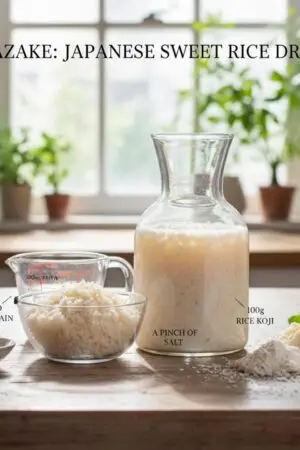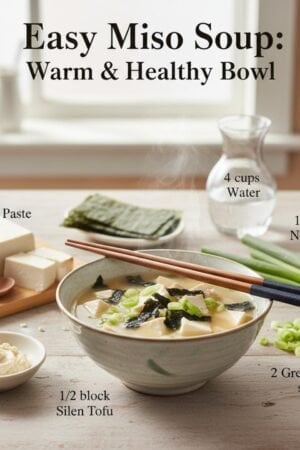Learn to cultivate Koji, the essential fungus (Aspergillus oryzae) that powers many traditional Japanese fermented foods. This starter can be used for miso, soy sauce, sake, and more, adding profound umami to your creations.

Unlocking Koji: Japan's Secret
Learn to cultivate Koji, the essential fungus (Aspergillus oryzae) that powers many traditional Japanese fermented foods. This starter can be used for miso, soy sauce, sake, and more, adding profound umami to your creations.
Ingredients
- 500 g short-grain white rice
- 5 g Koji spores (Aspergillus oryzae)
Instructions
- 1. Wash the rice thoroughly under cold running water until the water runs clear. Soak the rice for 6-8 hours or overnight.
- 2. Drain the soaked rice well. Steam the rice in a steamer basket or instant pot until it is cooked through but still firm, not mushy. Each grain should be distinct. Let it cool to approximately 95-100°F (35-38°C) – this temperature is crucial for Koji spore inoculation.
- 3. Spread the cooled, steamed rice evenly on a clean baking sheet or tray lined with a clean cloth. Sprinkle the Koji spores evenly over the rice. Gently but thoroughly mix the spores into the rice to ensure even distribution.
- 4. Transfer the inoculated rice to a clean tray or container suitable for incubation. Cover loosely with a lid or a damp, clean cloth to maintain humidity. Place the tray in an incubator set to a constant temperature of 85-95°F (30-35°C) with high humidity (around 70-85%).
- 5. Every 8-12 hours, check the Koji. Gently mix the rice to break up any clumps and promote even aeration and growth. Continue to monitor the temperature and humidity closely.
- 6. After 24-48 hours, you should observe a dense white mold-like growth (Koji mycelium) covering the rice grains, making them appear fuzzy and slightly sticky. The Koji will emit a sweet, fruity aroma.
- 7. Once the rice grains are fully covered with white Koji mycelium, your Koji starter is ready. It can be used immediately for making miso, sake, or other ferments, or it can be dried and stored in an airtight container in the refrigerator for later use.
Notes
Maintaining proper temperature (85-95°F / 30-35°C) and humidity is crucial for successful Koji growth. Use a dehydrator, proofing box, or oven with a light on for incubation. Good air circulation is also important to prevent unwanted mold. Fresh Koji has a sweet, slightly fruity aroma and a delicate white, fuzzy appearance. Sterilize all equipment thoroughly before use.






